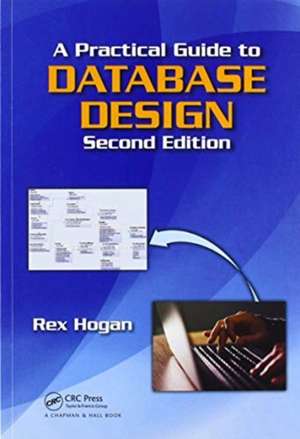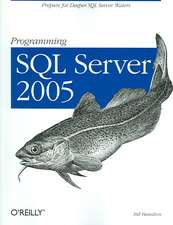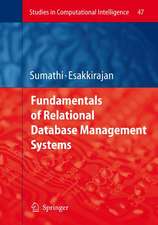A Practical Guide to Database Design
Autor Rex Hoganen Limba Engleză Paperback – 30 iun 2020
The book next shows how to use an industry-leading data modeling tool to define and manage logical and physical data models, and how to create Data Definition Language statements to create or update a database running in SQL Server, Oracle, or other type of DBMS.
One chapter is devoted to illustrating how Microsoft Access can be used to create user interfaces to review and update underlying tables in that database as well as tables residing in SQL Server or Oracle.
For users involved with Cyber activity or support, one chapter illustrates how to extract records of interest from a log file using PERL, then shows how to load these extracted records into one or more SQL Server “tracking” tables adding status flags for analysts to use when reviewing activity of interest. These status flags are used to flag/mark collected records as “Reviewed”, “Pending” (currently being analyzed) and “Resolved”. The last chapter then shows how to build a web-based GUI using PHP to query these tracking tables and allow an analyst to review new activity, flag items that need to be investigated, and finally flag items that have been investigated and resolved. Note that the book has complete code/scripts for both PERL and the PHP GUI.
| Toate formatele și edițiile | Preț | Express |
|---|---|---|
| Paperback (1) | 262.44 lei 6-8 săpt. | |
| CRC Press – 30 iun 2020 | 262.44 lei 6-8 săpt. | |
| Hardback (1) | 509.47 lei 6-8 săpt. | |
| CRC Press – 16 mar 2018 | 509.47 lei 6-8 săpt. |
Preț: 262.44 lei
Preț vechi: 377.12 lei
-30% Nou
Puncte Express: 394
Preț estimativ în valută:
50.27€ • 54.54$ • 41.89£
50.27€ • 54.54$ • 41.89£
Carte tipărită la comandă
Livrare economică 04-18 decembrie
Preluare comenzi: 021 569.72.76
Specificații
ISBN-13: 9780367571931
ISBN-10: 0367571935
Pagini: 430
Dimensiuni: 178 x 254 x 25 mm
Greutate: 0.76 kg
Ediția:Nouă
Editura: CRC Press
Colecția Chapman and Hall/CRC
ISBN-10: 0367571935
Pagini: 430
Dimensiuni: 178 x 254 x 25 mm
Greutate: 0.76 kg
Ediția:Nouă
Editura: CRC Press
Colecția Chapman and Hall/CRC
Cuprins
1. Overview of Databases 2. Normalization 3. Database Implementation 4. Normalization and Physical Design Exercise 5. The erwin Data Modeling Tool 6. Using Microsoft Access 7. Using SQL Server 8. Using Perl to Extract and Load Data 9. Building User Interfaces 10. Creating the University Database Application 11. PHP Implementation and Used
Notă biografică
Rex Hogan has over 40 years experience as a database administrator and as a software engineer. This includes over 17 years of experience with Southwestern Bell/AT&T where he became their lead database specialist. During this period, he also taught various undergraduate and graduate classes at Washington University’s Center for the Study of Data Processing in St. Louis, MO. He then worked for TRW/Northrop Grumman for 16 years, primarily as a DBA/senior software engineer where he became a specialist in the rapid design and development of database systems and applications. Finally, he worked for five years as a computer scientist for the Air Force Office of Special Investigations, where he developed computer systems to monitor usage of USAF internet traffic. He has authored and co-authored several books, including A Practical Guide to Database Design (first edition), Diagnostic Techniques for IMS DataBases,and Managing IMS Databases.
Descriere
This book contains a major update to the previous edition. It covers how to implement and manage the Database Management System (DBMS) itself, how to write scripts to extract and load data from source files, and how to develop user interfaces to view and update data within the database.




























